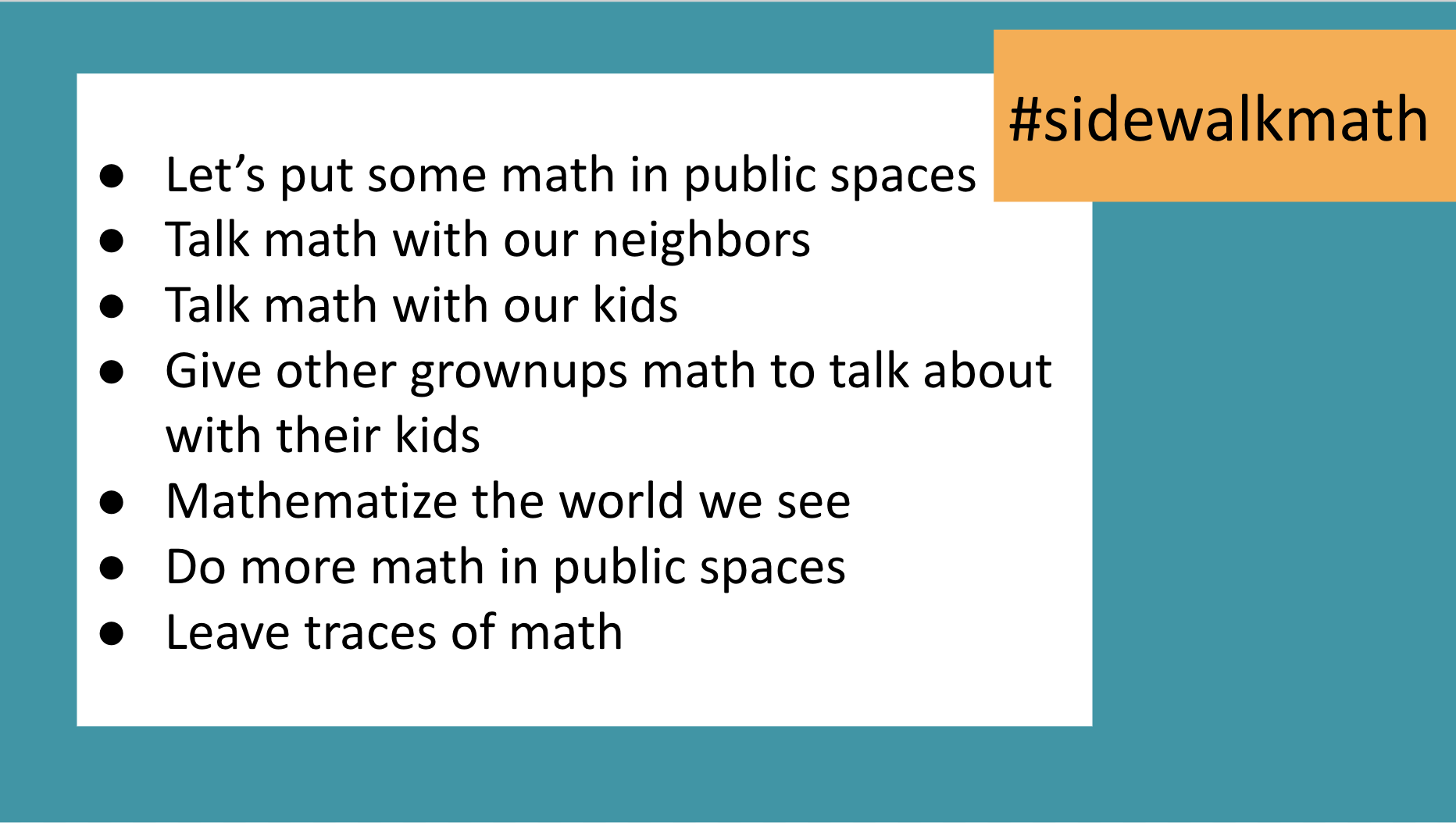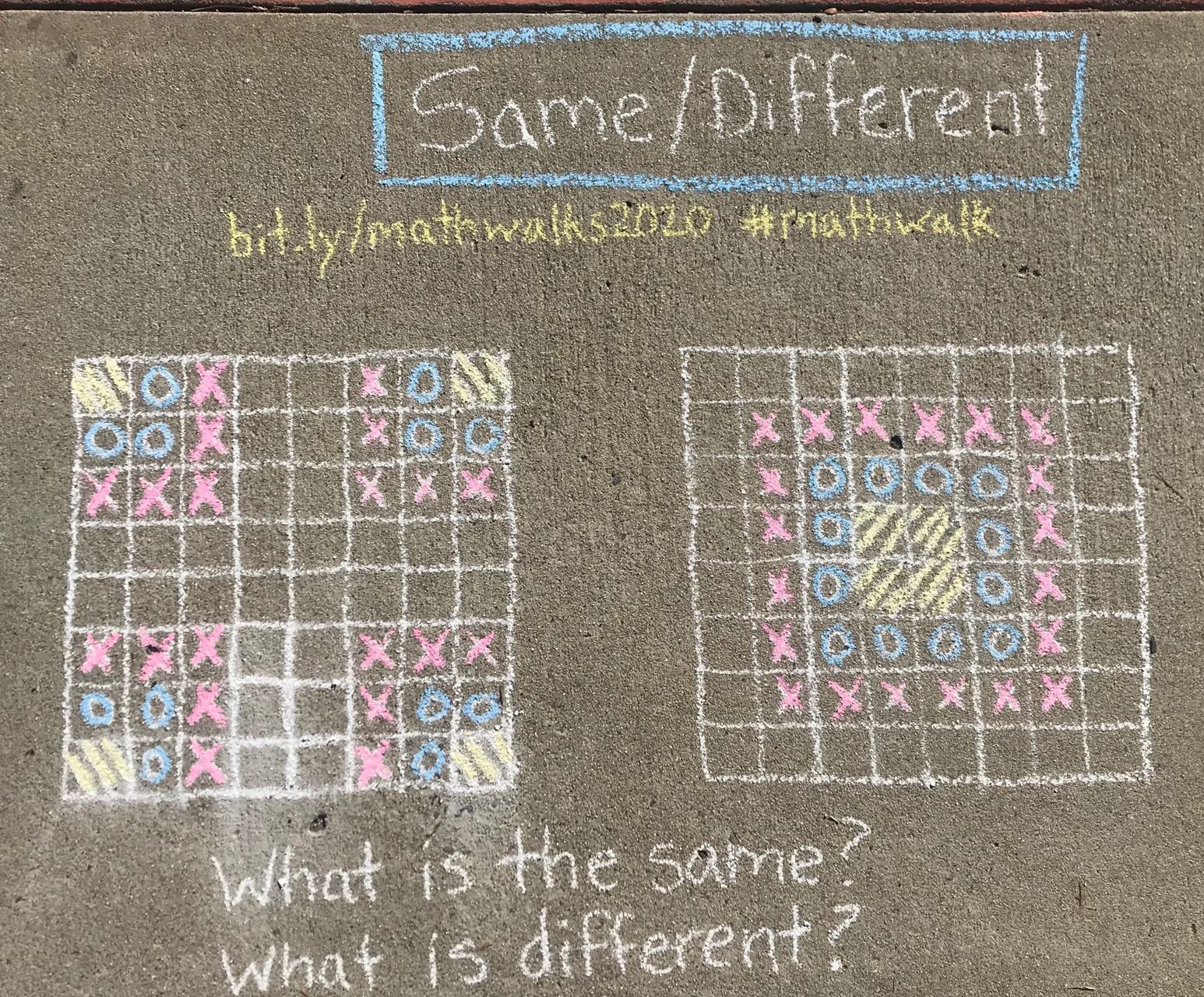In her 2019 ANN Under 10 talk, Making Math Viral, Christin Smith (KY) tries to resolve the paradox of people saying, "I am not a math person" with people sharing "viral math problems" over social media. In part, Christin chalks it up (pun intended) to a misconception of what it means to do math. In school, students learn that math was about right and wrong, speed, and knowing the procedures. Christin's goal in analyzing the phenomenon was to see what there is for us to learn what we can about the appeal of viral math problems. It is more than just using viral math problems in class. Christin's take is that there are two elements that give viral math problems their power: (1) they peak curiosity and (2) they promote controversy.
| | |
Another aspect of viral math problems is their location. They are curiosity peaking, controversy promoting, social experiences that happen outside of the classroom. In the last several years, there have been some grassroots explorations of where it means to do math. We are collecting some resources on this page to offer some inspiration for the doing of math in public spaces. Join the movement! Please share any pictures of math in public spaces, either using the hashtags mentioned below (don't forget to add #ANNMath) or email them to mathpractitioner@gmail.com 
|
SIDEWALK MATH
Let's chalk up our streets, broaden what it means to do math, spark curiosity and conversation (and use #sidewalkmath to tell each other about it).
#SidewalkMath is a hashtag made popular by Brian Palacios, a HS math teacher in the Bronx, NY. It is used by teachers, parents, and caregivers (but mostly teachers) across the US who leave math on the sidewalk and engage their communities, children and adults alike, in math conversations.
- Dr. Benjamin Dickman taught a class at the Hewitt School in NYC called Problem Solving and Posing. As part of the class his students chalked up city sidewalks with math problems for passersby to explore.
-
- Benjamin's class also created a #SidewalkMath Encyclopedia, collecting curiosity peaking problems from #sidewalkmath photos on Twitter.
-

| | |
MATH WALKS
Math Walks was started in March 2020 by Traci Jackson to encourage math discussion during quarantine. Photos of the math she has left along her path can be found at Math Walks. Making Cocoa and Same/Different are two examples. Other folks have been inspired by Traci's project. You can see what they have shared on Twitter using #MathWalks 
| | |

PUBLIC MATH: Where every person is a math person.
This group of educators creates mathematical opportunities in the spaces that diverse children and families inhabit and interact with in their daily lives. Check out their website, Public Math, and learn more about their projects: free postcards (order two today - for you and a friend), coasters, laundromats, zines. They even have an IOS sticker packet for your smartphone that allows you to add a prompt (What do you notice? What do you wonder? How Many? Which One Doesn't Belong? etc.) to your photos and videos. Check out Public Math Pop-Up: Mathematize Your Kitchen, to hear Chris Nho, Molly Daley, and Christopher Danielson, the organizers for Public Math. They talk about their goal of elevating the mathematical inner lives of others and putting it on equal footing with classroom math. They share the questions driving their work: How do we share our inner math wonderings in ways that inspire curiosity in others? How do we invite others to see their own mathematical inner lives? 
MATH ANYWHERE!
Math Anywhere! is a community-based project in Vancouver, Washington which aims to build positive math experiences outside of school. They believe (1) math can be playful, (2) interesting math-y ideas to explore exist all around us, wherever we go, (3) anytime is a good time to chat about math, and (4) everyone has important math thinking to share.
From the Math Anywhere website: We have been working to create place-based media and visiting with children and their grown-ups in different community spaces to share our ideas. You can explore some of the prompts we have created here. We hope these will broaden how you think about math and inspire you to play with math in the places you visit everyday.

MATH TRAILS
"A mathematics trail is a walk to discover mathematics. A math trail can be almost anywhere—a neighborhood, a business district or shopping mall, a park, a zoo, a library, even a government building. The math trail map or guide points to places where walkers formulate, discuss, and solve interesting mathematical problems. Anyone can walk a math trail alone, with the family, or with another group. Walkers cooperate along the trail as they talk about the problems. There’s no competition or grading. At the end of the math trail they have the pleasure of having walked the trail and of having done some interesting mathematics."
Math Trails is a guide to blazing your own math trail.

|
MATH INSTALLATIONSMathWithMeMN
‘Math With Me MN’ is a community engagement initiative out of St. Paul, Minnesota. Students and teachers, collectively, will create math installations and experiences in their homes and communities designed to connect people to each other and to mathematics. A ‘math installation’ is a math experience that gets people to think about math in a friendly, approachable way:
- To reignite joy and play in (distance) learning, and to maximize student agency.
- To see and experience mathematics in our homes, our communities, our public spaces.
- To start closing the ‘distance’ in distance learning.
| | |
SPATIAL JUSTICE & COUNTER-MAPPING
Learning to Map and Mapping to Learn Our Students' Worlds - Maps at four levels of scale—global, national, regional, and local—provide a context for mathematical investigations that help teachers learn about their students. This article offers some ideas.
Counter-Mapping the Neighborhood on Bicycles: Mobilizing Youth to Reimagine the City - Personal mobility is a mundane characteristic of daily life. However, mobility is rarely considered an opportunity for learning in the learning sciences, and is almost never leveraged as relevant, experiential material for teaching. This article describes a social design experiment for spatial justice that focused on changes in the personal mobility of six non-driving, African-American teenagers, who participated in an afterschool bicycle building and riding workshop located in a mid-south city. Our study was designed to teach spatial literacy practices essential for counter-mapping. “We were guided in the study by Soja’s (2010) concept of “spatial justice” as a way to intervene in the spatial relationship youth have with their neighborhoods, so that they might imagine new, more equitable possibilities for that geography. Similar to LeFebvre’s (1996) idea of the “right to the city” we understood spatial justice to be concerned with empowering those who were most negatively impacted by the urban infrastructure to take a stance in reconfiguring the city. Harvey (2008) made a similar argument for spatial justice as a living human right.”

|
Mathematics on the Move: Re-Placing Bodies in Mathematical Learning. (2015)
In this 5 minute Ignite talk, Dr. Jasmine Ma talks about the body's role in spatial reasoning and new questions for activity, participation, motivation and engagement: - What is it like outside?
- What am I like outside?
- What is math like outside?
“The challenge for us, if we care about kids learning and their humanity, is to embrace the mess, the smells, the hormones, the specificity of their bodies, because that is a feature, not a bug of their learning and should be leveraged rather than fixed or erased.”
| | |
MATH-ON-A-STICK
Math-On-A-Stick is a welcoming space where kids and grown-ups can explore fun math concepts at the Minnesota State Fair.
Math-on-a-Stick's Twitter Feed
In the summer of 2019, ANN's annual board meeting was held in Minnesota at the same time as Math-on-a-Stick and the board was able to volunteer on a day sponsored by I Am ABE. Read more in this article from the Math Practitioner, ANN Goes to Math-On-A-Stick, August 2019
| | |

Research
|
|